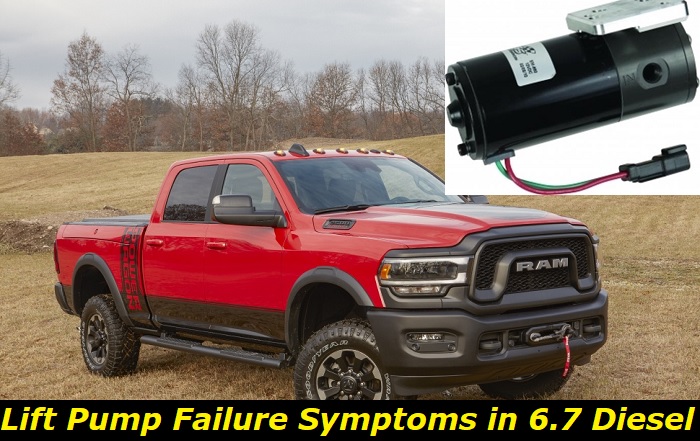The lift pump in a 6.7L Cummins engine is responsible for pumping a steady amount of fuel from the fuel tank to the Bosch high-pressure common-rail injectors. It is a high-pressure pump that is capable of delivering fuel at a pressure of 3,000 psi more compared to the preceding 5.9L engine. The lift pump is an important component of the fuel system and plays a vital role in ensuring that the engine runs smoothly and efficiently.
Key features and my opinion about the engine
- Production years:2007-now
- Average lifespan of 6.7 Cummins:350,000-500,000 miles
- Fuel supply type:Common Rail
- Power range:150-420 hp
- Fuel efficiency:bad
- Engine block material:cast iron
- Engine reliability score:high
- The most common problems:fuel supply issues, head gasket failure, turbocharger problems.

Advantages Offered by a Properly Working Lift Pump in the 6.7L Cummins Engine
There are several advantages offered by the lift pump of the Cummins engine, including:
1. Reduced Emissions
Lift pumps reduce emissions by ensuring that fuel is delivered to the injectors at the correct pressure. This prevents fuel from being wasted and also decreases the amount of unburned fuel that enters the exhaust system.
2. Improved Performance
Lift pumps bring about improved engine performance by delivering fuel more efficiently to the engine. This helps increase power and torque. Specifically, it contributes to the capability of the 6.7L Cummins to deliver 350 to 385 hp and 650 to 900 lb-ft of torque in its various factory configurations.
3. Increased Reliability
Lift pumps are designed to be durable and reliable, and can last for the life of the engine. They are also easy to maintain and replacement parts are easy to source, especially for the 6.7L Cummins engine, making them an ideal choice for those who want a hassle-free fuel system. It is partly responsible for the high reliability of the 6.7L Cummins, which Ram claims to be capable of lasting around 350,000 miles at its best and with periodic maintenance.
4. Increased Fuel Efficiency
Lift pumps help improve fuel efficiency by ensuring that fuel is delivered at the correct pressure. This helps prevent fuel from being wasted and also decreases the amount of unburned fuel that enters the exhaust system. It aids the 6.7L engine to maintain a fuel economy at an estimated 12 mpg in city drives, 18 mpg in highway drives, and 15 mpg combined.
Symptoms of Lift Pump Failure in the 6.7L Cummins Engine
Overall, the lift pump is a crucial component of the fuel system and plays a vital role in ensuring that the engine runs smoothly and efficiently. There are certain signs that you should watch out for that may mean failure of this component.
Any, or the combination, of the following elements can point out to a failure in the lift pump of the 6.7L Cummins:
1. Trouble Starting the Engine
If the lift pump fails, it can cause a delay in starting the engine. This is because the lift pump is responsible for supplying fuel to the injectors. If the lift pump is not working, the fuel cannot reach the injectors and the engine will not start.
2. Low Fuel Pressure
If the lift pump fails, it can no longer supply enough fuel to the injectors. This leads to low fuel pressure, which can cause engine performance issues. Low fuel pressure can cause the engine to run lean, misfire, and eventually stall. It can also damage the fuel injectors and other engine components, too.
3. Less Compression
Since the lift pump is a key component in a vehicle's fuel system, which is responsible for drawing fuel from the tank and delivering it to the injection system, its failure can lead to low compression or even compression failure. This is because the fuel is not being delivered to the cylinders at the correct pressure, resulting in poor combustion and engine performance. In extreme cases, a failed lift pump can even cause the engine to stall.
4. Injector Failure
A lift pump is a vital component of a diesel engine, and its failure can have serious consequences. If the lift pump fails, it can cause the injectors to seize, resulting in a series of chain reactions that will eventually cause damage to the engine.
5. Slow Cranking in the Engine
If the engine is having difficulty cranking up, it could be due to a lift pump failure. Again, this is due to the engine not getting the right amount of fuel. This can lead to slow cranking or even stalling. If you're having trouble with your engine cranking slowly, it's worth checking to see if your lift pump is functioning well.
6. Insufficient Fuel Supply
Fuel injectors are responsible for delivering fuel to the engine, and they work hand-in-hand with the lift pump. When they fail, fuel delivery can be disrupted. This can lead to engine misfires, reduced power, and decreased fuel economy.
7. Increased Emissions
In some cases, a damaged or failed injector because of a bad lift pump may also cause the engine to run lean, which can result in increased emissions. The color of the smoke produced by the exhaust may also change ranging from bluish hues to black.
8. High Fuel Consumption
If the lift pump is not working properly, the engine will not be able to get the sufficient fuel it needs and will have to work harder to run. This can lead to an increase in fuel consumption.
9. Acceleration Issues
Lift pump failure can prevent the engine from receiving the right amount of fuel, and it can lead to problems with the vehicle's acceleration.
10. Fuel Leaks
In some cases, a failed lift pump can cause fuel to spill into the engine, which can lead to engine damage. Additionally, if the fuel leak will reach the parts of the engine bay that emits high levels of temperature, this can result in fire.
11. Engine Sputtering
Sputtering is a type of engine noise that sounds like a rapid clicking or popping. It is generally caused by an insufficient amount of fuel being delivered to the engine, which can lead to a loss of power and other problems.
12. Overheating
If the fuel lift pump fails, it can no longer supply fuel to the engine at the correct pressure. This can cause the engine to overheat as it is not receiving the proper amount of fuel and it struggles to function as it should. Additionally, the lift pump is responsible for keeping the fuel system clean and free of debris. If it fails, dirt and other contaminants can enter the system and clog injectors or damage other components.
Solutions to Lift Pump Failure in the 6.7L Cummins Engine
There are a few ways for you to address issues related to the lift pump of the 6.7L Cummins engine depending on the severity of the problem it is experiencing. These are the following:
1. Recalibration
The calibration of the lift pump is important because it ensures that the pump is able to accurately deliver the correct amount of fuel to the engine. If the pump is not properly calibrated, it can result in either too much or too little fuel being delivered to the engine, which can lead to engine performance issues. Properly calibrating the lift pump will help ensure optimal engine performance and fuel efficiency.
2. Repair
The proper connection of the lift pump is important because it helps ensure that the pump is able to function properly. Additionally, if the lift pump is not properly connected, it could lead to leaks or other issues.
To check for proper connections, visually inspect the pump and all connections. Make sure that there are no loose wires or anything else that looks out of place. Additionally, you can use a voltmeter to test the connections to ensure that they are tight and secure.
If you are using a voltmeter, set the meter to read Ohms. Then, test each connection by placing the meter's leads on each connector. You should get a reading of zero or very close to it. If you get a reading that is not close to zero, there is likely a problem with that connection and it should be fixed.
If you find that the connections are not proper, simply tighten them down or re-seat them as needed. If you're still having issues, then you may need to replace the lift pump entirely.
3. Replacement
The lift pump is located on the right side of the 6.7 Cummins engine, just below the fuel filter. It can be reached by removing the air intake cover and the fuel filter cover.
If your lift pump has seized, has shown signs of damage, or is no longer working properly, you will need to replace it. This is a relatively simple process that can be completed in a few steps.
- First, remove the old lift pump from its location. This will require unbolting or disconnecting it from its mounts.
- Next, install the new lift pump in the same location. Make sure that it is properly secured and connected.
- Finally, test the new lift pump to make sure it is working properly. Once you have verified that it is functioning correctly, you can put everything back together and reconnect any hoses or lines that were disconnected during installation.
Conclusion
With the details shown to you here, we can't stress enough the importance of a properly functioning lift pump in your 6.7L Cummins engine. It plays an important part in the proper flow of fuel in the engine, and its failure can be catastrophic. Therefore, you should recognize symptoms relating to its impending or eventual failure to at least mitigate the chances of the problem getting more complicated to repair.
About the authors
The CarAraC research team is composed of seasoned auto mechanics and automotive industry professionals, including individuals with advanced degrees and certifications in their field. Our team members boast prestigious credentials, reflecting their extensive knowledge and skills. These qualifications include: IMI: Institute of the Motor Industry, ASE-Certified Master Automobile Technicians; Coventry University, Graduate of MA in Automotive Journalism; Politecnico di Torino, Italy, MS Automotive Engineering; Ss. Cyril and Methodius University in Skopje, Mechanical University in Skopje; TOC Automotive College; DHA Suffa University, Department of Mechanical Engineering






Add comment